Heritage
Kashipath 2019 Day 4: Ellora’s Kailasha Cave, Where The Depictions Of Shiva Have Inspired Millions Through Millennia
Aravindan Neelakandan
Nov 25, 2019, 05:49 PM | Updated Nov 26, 2023, 12:52 PM IST
Save & read from anywhere!
Bookmark stories for easy access on any device or the Swarajya app.
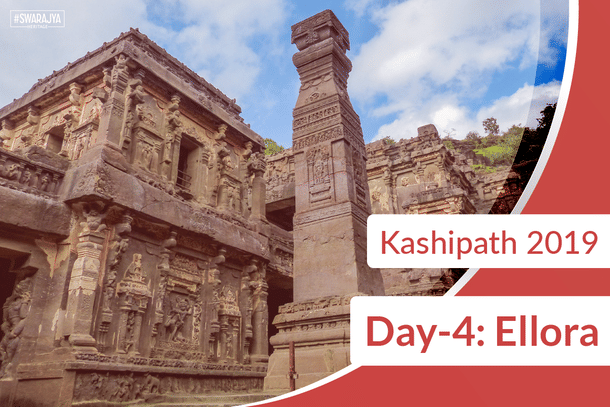
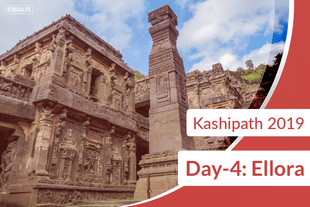
"God does not play dice with the universe," Albert Einstein had said famously with respect to quantum mechanics. He could not accept the blurring of lines between the observer and the observed. Nor could he accept a worldview that partially denied the completely objective reality.
Danish physicist Niels Bohr known for his interest in Eastern mystic traditions famously retorted, "Dear Einstein, please stop telling God what to do!" And here, we do see the dancer who makes all existence dance into dissolution and being, doing exactly that – playing dice with the goddess. Avyakta or the undefinability is very much a part of the fabric of reality at every level and in every domain. What else conveys it better to the Indian mind than the scene of Shiva and Parvati playing dice?
We are standing before a huge relief depicting the scene in Kailasha – the sacred mountainous abode of Shiva. One wonders if Niels Bohr and Einstein were to stand before this relief and discuss the same problem, how each of them would have reacted.

Yes, we are in Ellora or Elapura.
As the fourth day of Kashipath dawned, our ever-active Jones was not exactly feeling at the top of his form. But within hours he pulled himself up.
We are at Ellora or Elapura as it was called once. We need to choose. We have one day, and we have to choose from the 34 caves. Ellora caves are in a way unique in the sense all the three great Indic spiritual traditions are represented here – Vedic (primarily Saivaite), Buddhist and Jain. Thus, here we see that the builders, probably Rashtrakutas, patronised all the three great traditions.
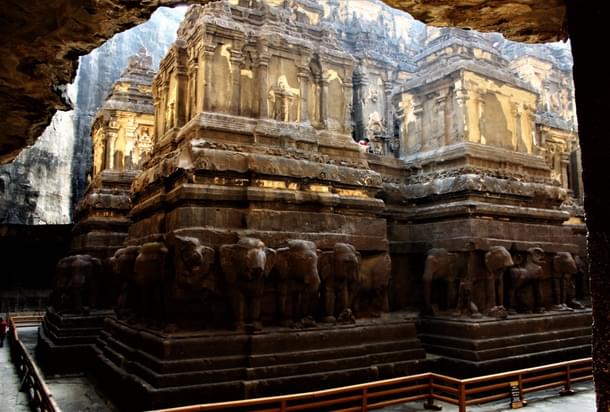
We have to choose among all these caves. We chose cave 16 – Kailasha. Here, the rock cut architectural skills of Hindu civilisation reached such a height that even today it defies the imagination as to how they built it. The sculptors have removed an entire mountain and chiselled their way top to bottom vertically carving the most marvellous depictions of Shiva – his famous deeds which have inspired devotees and mystics through millennia.
We enter the temple that shows both Narasimha and Varaha. It also shows the Shiva dancing – the sculptor had succeeded in capturing the flow of the movement and one can see Ganga lovingly stroking or massaging his matted hair locks even as he dances.
Inside the important sculptures facing each other are Shiva as Gajasamhara Murti and Shiva as Dakshinamurthy. Note the apparently paradoxical positioning – in one, he skins the hide of the elephant that is the darkness that emerges when one’s ego is vanquished.
Though ferocious and aggressive in slaying the mammoth like negativity, he lovingly places his hand on his consort Parvati.
In Shaivism, it is she who shall ultimately make us immerse in his love and hence his assurance to her is assurance to us all. Facing this depiction, we see him as Dakshinamurthy – without a single word – all silent. Youthful is the guru, and old men his disciples, the seer would sing about this scene. But juxtaposition of these two makes one feel the two complementary nature of Shiva harmonised in one place.
Then there is Tripurantaka where Shiva stands with his bow – which would be Meru itself and the bow string would be the cosmic serpent Vasuki and the universe the chariot, Brahma the charioteer and Agni the missile, the Vedas the horses. The Tripura represents the three inner impurities, informs the Shaivaite sacred texts.
At Ravana-Anugraha Murti, we see Ravana trying to lift Mount Kailash and Shiva subdues him with his toe nail. Then the demon king of Lanka would have to please the lord by playing the veena, the strings of which he would make with his own intestine and the sphere with his head.
Apart from Shiva slaying Kala, who tried to take the life of his devotee Markanda, there is also Shiva slaying Antaka – the demon born out of darkness.
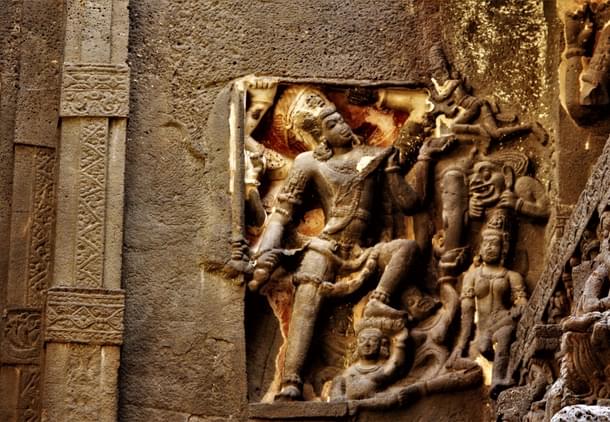
Kailasha temple also has beautiful narratives from the Ramayana and Mahabharata on either side of the mandapa. The national epics of India shown on either side also indicate the oneness of the nation.
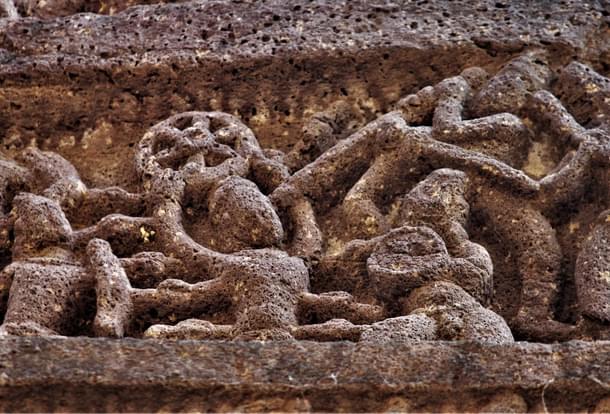
There are mural paintings very similar to Ajanta. However, most of them are lost. Local traditions say that Mughal ruler Aurangazeb ordered the destruction of the temple. One could see the tell-tale signs of destruction. Yet, whoever tried to destroy it could not accomplish the task. The temple still stands proud.
Amar Chitra Katha as well as local legends inform us how a queen had prayed for the recovery of her diseased husband and had vowed to fast until the kalasa or pinnacle structure of the temple – the last part to be completed in a temple construction – would be completed. She had chosen the mountain at the site of ‘cave 16’.
Clearly, all sculptors said that such a temple, as the queen wished, would take years if not decades to build, and the queen would die if she fasted that long. At last, one master sculptor named Kokasa declared that he would be able to complete the kalasa of the temple within a week. Everyone expressed their disbelief and even ridiculed him.
But what he did was unprecedented. He built the pinnacle first and then started building the temple from top to the bottom by carving out the stones with his workers. Historian M K Dhavalikar does not discount this as mere legend but theorises that there may be a kernel of truth to it as evidence from inscriptions of later centuries do mention the sculptors in the lineage of Kokasa.
Inside the temple corridors meant for circumambulation we see reliefs after reliefs which depict the avatars of Vishnu and the grand deeds of Shiva including him being personified as Kala Samhara Murti. A particularly interesting series of depictions show Ravana severing his nine heads and gets ready to sever his tenth for getting the special Shiva Linga that would make him invincible. Parvati is indeed reluctant and advises Shiva against giving it to Ravana. Later puranas tell us how Ganesha would make sure that the linga that bestows invincibility was not taken to Lanka.
As we move on to the first floor we come to the sanctum sanctorum where the majestic Shiva Linga is placed. A sense of serenity envelops the place. The monument is under the control of the Archaeological Survey of India (ASI), and there is no worship and yet people remove their footwear and stand in reverence before the Shiva Linga. The monument is still living whether there is worship or not.
As we come outside, we see that most of the visitors are lost in taking selfies before each and every carved sculpture. Even groups that come with guides simply wait impatiently for the guide to finish and then take selfies. Ravana lifting the mountain gets his ego subdued by Shiva and right before that ‘let us take a selfie’ for this looks kind of amusing and shall make good for an Instagram picture – seems to be the attitude.
Clearly, most of them are Hindus and they do not even know what they are missing by not pausing in front of a sculpture here, a relief there and gently pause.
Ellora is a great opportunity for cultural and spiritual outreach. It is not just an ancient monument but also a monument of worship and meditation of a living culture, which is unique to the world.
Trip partner: Rent a car in Indore with an experienced driver - use Savaari Car Rentals
One need not start the ritual worship but can train the guides to convey to every visitor the puranic and spiritual significance of these reliefs and sculptures. They are not mere ‘mythological’ stories as the guides right now tell. They are puranic narrations having multiple layers of meaning.
Like, for example, the panel that shows Shiva playing the dice. A display that tells the visitors the significance of a game of dice even in the modern cosmology would make the visitor understand how she stands before a monument built so marvellously as a dedication to the infinite, and to the infinite ways in which we humans approach the divine despite being as insignificant as dust physically before the immensity of the universe.
Both ASI and Department of Culture are sitting on a unique opportunity no other culture has on this planet, and let them understand their inescapable responsibility.
So the sun comes down and we have to leave. We leave still soaking in the beauty of Kailasha of Ellora.
You can read the other Kashipath articles here.
This article is part of Swarajya’s Heritage Program. If you liked this article and would like us to do more such ones, consider being a sponsor – you can contribute as little as Rs 2,999. Read more here.
Aravindan is a contributing editor at Swarajya.




